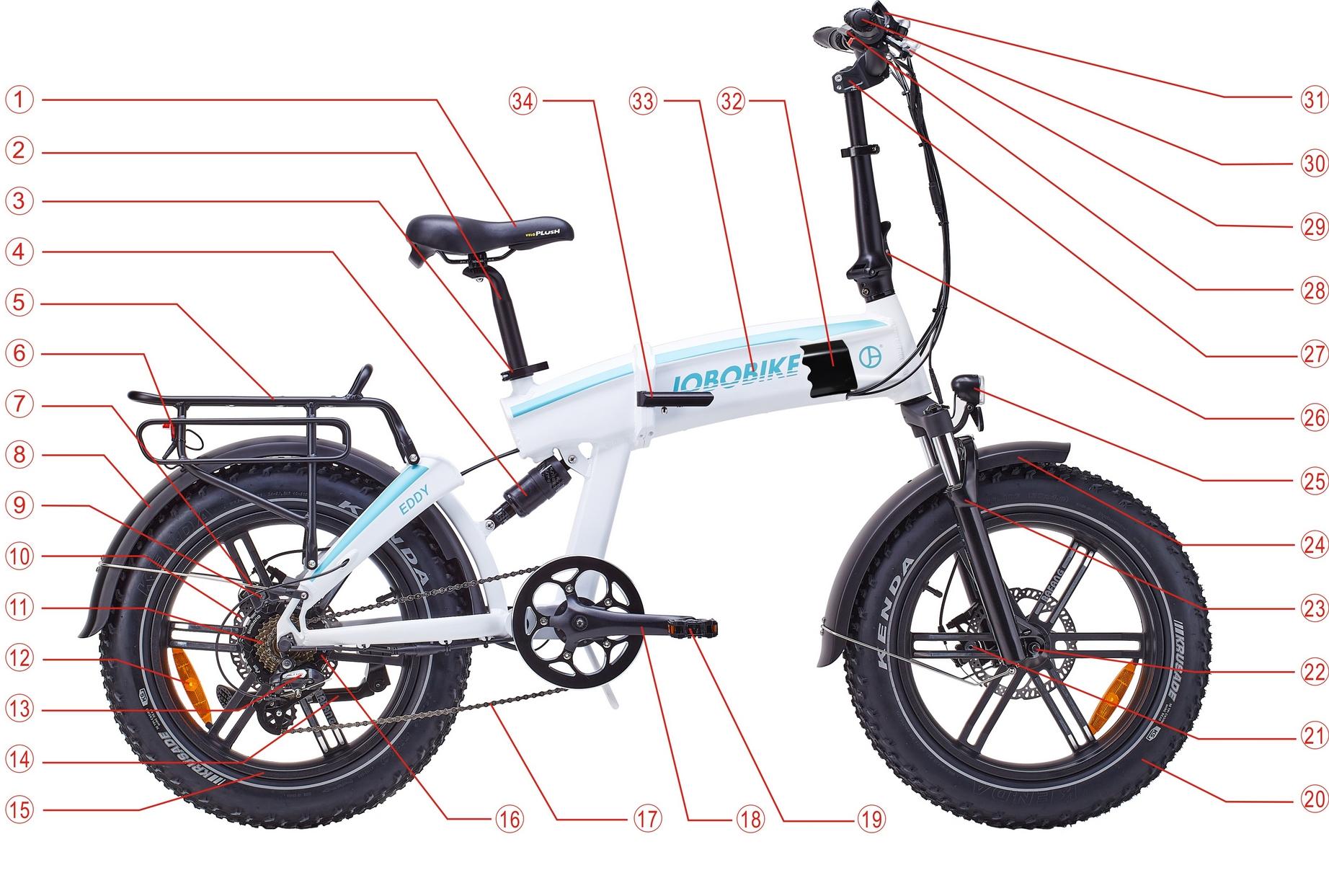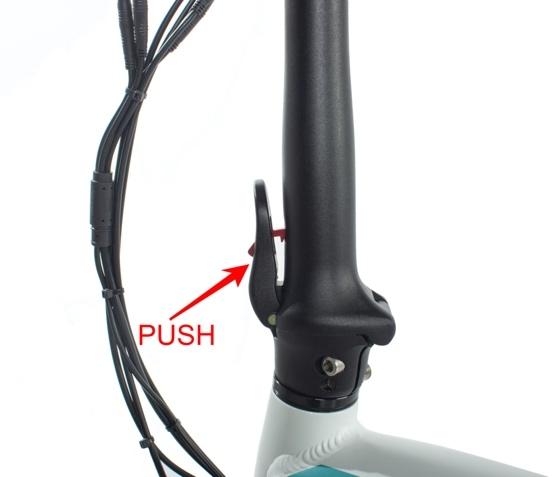
8 minute read
Maintenance
from Eddy manual
by returos
Maintenance Basic Bike Care To ensure safe riding conditions, you must maintain your bike properly. Follow these basic guidelines and see a certified bike mechanic at regular basis to ensure your bike is safe for use and comfortable to ride. See the Safety Checklist and Recommended Service Intervals sections of this manual for more detailed information. • Properly maintain batteries by keeping them fully charged when there are two weeks or longer between uses. See Long-Term Battery Storage section of this manual for information on storing the battery for longer than two weeks between rides. • Never immerse or submerge the bike or any components in any liquid as the electrical system may be damaged. • Periodically check wiring and connectors to ensure that the connectors are secure without damages. • To clean, wipe the frame with a damp cloth. If needed, apply a mild, non-corrosive detergent mixture to the damp cloth and wipe the frame. Dry the frame by wiping with a clean, dry cloth. • Store under shelter; avoid leaving the bike in the rain or to any corrosive materials. When the bike is exposed to rain, dry your bike and apply anti-rust treatment to the chain and other unpainted steel surfaces. • Riding on a beach or in coastal areas exposes your bike to salt, which is very corrosive. Wipe down your bike frequently and wipe or spray all unpainted parts with anti-rust treatment. Damage from corrosion is not covered under warranty so take special care to extend the life of your bike if you use it in coastal areas or areas with salty air or water. • If the hub and bottom bracket bearings have been submerged in water or liquid, they should be taken out and re-greased. This will prevent accelerated bearing deterioration. • If the paint has become scratched or chipped in the metal, use touch up paint to prevent rust. Clear nail polish can also be used as a preventative measure. • Regularly clean and lubricate all moving parts; tighten and adjust components as required. • Regularly inspect all pre-attached and optional component hardware to ensure proper torque spec, secure attachment, and good working condition.
37
Advertisement
Recommended Service Intervalsn teable Regular inspection and maintenance are the keys to ensure that bikes function properly, and to reduce wear and tear on their systems. Recommended service intervals are meant to be used as guidelines. Real world wear and tear, and the need for service, vary with conditions of use. We generally recommend inspections, service, and necessary replacements to be performed at the time or mileage interval that comes first in the following table.
Interval
Weekly 150–300km (62.5–187.5 mi)
Monthly (220–750 mi)
Every 6 Months 1200–2080 km (750–1300 mi)
Inspect - Check hardware for proper torque:See Recommended Torque Values chart. - Check drivetrain for proper alignment and function (including the chain, freewheel, chainring, and derailleur). - Check wheel trueness and for quiet wheel operation (without spoke noise). - Check condition of frame for any damage 350-1200km
- Check brake pad alignment, brake cabletension. - Check bike is shifting properly, proper derailleur cable tension. - Check chain stretch. - Check brake and shifter cables for corrosion or fraying. - Check spoke tension. - Check accessory mounting (rack mounting bolts, fender hardware, and alignment). - Inspect drivetrain (chain, chainring, freewheel, and derailleur). - Inspect all cables and housings.
Service - Clean frame by wiping frame down with damp cloth. - Use barrel adjuster(s) to tension derailleur/brake cables if needed.
- Clean and lubricate drivetrain. - Check crankset and pedal torque. - Clean brake and shift cables. - True and tension wheels if any loose spokes are discovered.
Replace - Replace any components confirmed by JOBOBIKE Technical Support or a certified, reputable bike mechanic to be damaged beyond repair or broken.
- Replace brake and shift cables if necessary. - Replace brake pads if necessary.
- Standard tune-up by certified, reputable bike mechanic is recommended. - Grease bottom bracket. - Replace brake pads. - Replace tyres if necessary. - Replace cables and housings if necessary.
38
Before every ride, and after every 32-80 km (20-50 mi), we recommend following this safety checklist.
Safety Check
Brakes
Wheels and Tyres
Steering
Chain Bearings
Cranks and Pedals Derailleur and Mechanical Cables Frame, Fork, and Seat Basic Steps
Ensure that front and rear brakes work properly. Check brake pads for wear and ensure that they are not over worn. Ensure that brake pads are correctly positioned in relation to the brake rotors. Ensure that brake cables are lubricated, correctly adjusted without any obvious wear. Ensure that brake levers are lubricated and tightly secured to the handlebar. Test if the brake levers are firm and that the brake, motor cutoff functions, and the brake light are functioning properly. Ensure that tyres are inflated within the recommended limits posted on the tyre sidewalls and hold air. Ensure that tyres have good tread with no bulges, excessive wear, or any other damage. Ensure that rims run true without any obvious wobbles, dents, or kinks. Ensure that all wheel spokes are tight and not broken. Check axle nuts and front wheel quick release to ensure that they are tight. Ensure that the locking lever on the quick release skewer is correctly tensioned, fully closed, and secured. Ensure that the handlebar and stem allow proper steering and are correctly adjusted, tightened. Ensure that the handlebar is set correctly in relation to the forks and the direction of travel. Ensure that the chain is clean, oiled, and runs smoothly. Extra care is required in wet, salty/otherwise corrosive, or dusty conditions. Ensure that all bearings are lubricated, run freely, and display no excess movement, grinding, or rattling. Check headset, wheel bearings, pedal bearings, and bottom bracket bearings. Ensure that pedals are securely tightened to the cranks and the cranks are securely tightened, not bent. Check to make sure that the derailleur is adjusted and functioning properly. Ensure shifter and brake levers to be attached to the handlebar securely. Ensure that all shifter and brake cables are properly lubricated. Check to make sure that the frame and fork are not bent or broken.
39
Motor Drive Assembly and Twist power assist
Battery
Electrical Cables
Accessories If either frame or fork is bent or broken, they should be replaced. Check that the seat is adjusted properly, and seatpost quick release lever is securely tightened. Ensure that the hub motor is spinning smoothly and the motor bearings are in good working condition. Ensure that all power cables running to hub motor are secured and undamaged. Make sure that the hub motor axle bolts are secured with the torque arm and torque washers in place. Ensure that battery is charged and without damage before each use. Lock battery to frame and ensure that it is secured. Charge and store the bike in a dry location with a temperature between 10 °C–25 °C (50 °F–77 °F). Let bike dry completely before using again. Look over connectors to make sure they are fully seated and free from debris or moisture. Check cables and cable housing for obvious signs of damage. Ensure that the headlight is funtioning and adjusted properly without being unobstructed. Ensure that all reflectors are properly fitted and not obscured. Ensure that all other fittings on bike are properly secured and functioning. Inspect helmet and other safety gears for signs of damage. Ensure that the rider is wearing a helmet and other required riding safety gears. Ensure that the mounting hardware is secured when fitted with a front rack, rear rack, basket, etc. Ensure that the taillight and taillight power wire are properly secured when fitted with rear rack. Ensure that the fender mounting hardware is properly secured with no cracks or holes in fenders.
Your cables, spokes, and chain will stretch after an initial break-in period of 80-160 km (50-100 mi), and bolted connections could loosen. Always have a certified bike mechanic perform a tune-up on your bike after your initial break-in period of 80–160 km (50–100 mi) (depending on riding conditions such as total weight, riding characteristics, and terrain). Regular inspections and tune-ups are particularly important for ensuring that your bike remains safe and comfortable to ride.
40
Tyre Inflation and Replacement
The EDDY employs 20" x 4.0" rubber tyres, which require 20” x 3.5 – 20” x 4” inner tubes. The tyres are designed for durability and safety during regular cycling activities; they should be checked before each use for proper inflation and condition. Proper inflation, care, and timely replacement ensure that your bike’s operational characteristics are maintained, avoiding unwanted, unsafe situations. JOBOBIKE recommends 20 - 30 psi/1.4 – 2.1 bar for both the front and rear tyres. Always stay within the manufacturer’s recommended air pressure range as listed on the tyre sidewall.
It is critically important that proper air pressure is always maintained in pneumatic tyres. Do not underinflate or overinflate your tyres. Low pressure may result in loss of control, and overinflated tyres may burst. Failure to always maintain the air pressure rating indicated on pneumatic tyres may result in tyre and/or wheel failure. Inflate your tyres from a regulated air source with an available pressure gauge. Inflating your tyres from an unregulated air source could overinflate them, resulting in a burst tyre.
Even tyres equipped with built-in flat-preventative tyre liners can get flats from punctures, pinches, impact, and other causes. When tyre wear becomes evident or a flat tyre is discovered, you must replace the tyres and/or tubes before operating the bike or injury to operators and/or damage to your bike could occur.
When changing a tyre or tube, ensure that all air has been removed from the inner tube prior to removing the tyre from the rim. Failure to remove all air pressure from the inner tube could result in serious injury, unsafe riding condition, or damage to your bike. If required by law, and for adequate visibility, ensure replacement aftermarket tyres have sufficient reflective sidewall striping.
41





